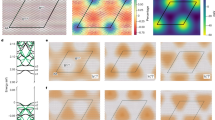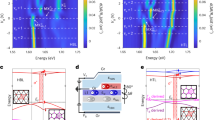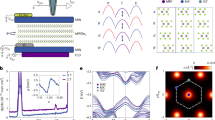Abstract
The emergence of moiré materials with flat bands provides a platform to systematically investigate and precisely control the correlated electronic phases. Here we report on a rich phase diagram of interpenetrating Hofstadter states—also called Chern insulators—and electron solids in a twisted WSe2/MoSe2 heterobilayer using local electronic compressibility measurements. We show that this reflects the presence of both flat and dispersive moiré bands whose relative energies, and therefore occupations, are tuned by the density and magnetic field. At low density, the competition between moiré bands leads to a transition from the commensurate arrangements of singlets at doubly occupied sites to triplet configurations at high fields. Hofstadter states are generally favoured at high density as dispersive bands are populated, but are suppressed by an intervening region of re-entrant charge-ordered states in which holes originating from multiple bands cooperatively crystallize. Our results reveal the key microscopic ingredients that favour distinct correlated ground states in semiconductor moiré systems, and they demonstrate an emergent lattice model system in which both interactions and band dispersion can be experimentally controlled.
This is a preview of subscription content, access via your institution
Access options
Access Nature and 54 other Nature Portfolio journals
Get Nature+, our best-value online-access subscription
$29.99 / 30 days
cancel any time
Subscribe to this journal
Receive 12 print issues and online access
$209.00 per year
only $17.42 per issue
Buy this article
- Purchase on Springer Link
- Instant access to full article PDF
Prices may be subject to local taxes which are calculated during checkout




Similar content being viewed by others
Data availability
Source data are provided with this paper. All other data that support the findings of this study are available from the corresponding author upon reasonable request.
Code availability
The codes that support the findings of this study are available from the corresponding author upon reasonable request.
References
Kravchenko, S. V. & Sarachik, M. P. Metal-insulator transition in two-dimensional electron systems. Rep. Prog. Phys. 67, 1–44 (2003).
Sarma, S. D. & Pinczuk, A. Perspectives in Quantum Hall Effects: Novel Quantum Liquids in Low-Dimensional Semiconductor Structures (John Wiley & Sons, 2008).
Gross, C. & Bakr, W. S. Quantum gas microscopy for single atom and spin detection. Nat. Phys. 17, 1316–1323 (2021).
Kennes, D. M. et al. Moiré heterostructures as a condensed-matter quantum simulator. Nat. Phys. 17, 155–163 (2021).
Mak, K. F. & Shan, J. Semiconductor moiré materials. Nat. Nanotechnol. 17, 686–695 (2022).
Wu, F., Lovorn, T., Tutuc, E. & MacDonald, A. H. Hubbard model physics in transition metal dichalcogenide moiré bands. Phys. Rev. Lett. 121, 026402 (2018).
Pan, H., Wu, F. & Das Sarma, S. Quantum phase diagram of a moiré-Hubbard model. Phys. Rev. B 102, 201104 (2020).
Tang, Y. et al. Simulation of Hubbard model physics in WSe2/WS2 moiré superlattices. Nature 579, 353–358 (2020).
Regan, E. C. et al. Mott and generalized Wigner crystal states in WSe2/WS2 moiré superlattices. Nature 579, 359–363 (2020).
Xu, Y. et al. Correlated insulating states at fractional fillings of moiré superlattices. Nature 587, 214–218 (2020).
Li, T. et al. Charge-order-enhanced capacitance in semiconductor moiré superlattices. Nat. Nanotechnol. 16, 1068–1072 (2021).
Jin, C. et al. Stripe phases in WSe2/WS2 moiré superlattices. Nat. Mater. 20, 940–944 (2021).
Huang, X. et al. Correlated insulating states at fractional fillings of the WS2/WSe2 moiré lattice. Nat. Phys. 17, 715–719 (2021).
Liu, E. et al. Excitonic and valley-polarization signatures of fractional correlated electronic phases in a WSe2/WS2 moiré superlattice. Phys. Rev. Lett. 127, 037402 (2021).
Chu, Z. et al. Nanoscale conductivity imaging of correlated electronic states in WSe2/WS2 moiré superlattices. Phys. Rev. Lett. 125, 186803 (2020).
Li, H. et al. Imaging moiré flat bands in three-dimensional reconstructed WSe2/WS2 superlattices. Nat. Mater. 20, 945–950 (2021).
Li, T. et al. Continuous Mott transition in semiconductor moiré superlattices. Nature 597, 350–354 (2021).
Chang, M.-C. & Niu, Q. Berry phase, hyperorbits, and the Hofstadter spectrum: semiclassical dynamics in magnetic Bloch bands. Phys. Rev. B 53, 7010–7023 (1996).
Cao, Y. et al. Unconventional superconductivity in magic-angle graphene superlattices. Nature 556, 43–50 (2018).
Eisenstein, J. P., Pfeiffer, L. N. & West, K. W. Negative compressibility of interacting two-dimensional electron and quasiparticle gases. Phys. Rev. Lett. 68, 674–677 (1992).
Skinner, B. & Shklovskii, B. I. Anomalously large capacitance of a plane capacitor with a two-dimensional electron gas. Phys. Rev. B 82, 155111 (2010).
Foutty, B. A. et al. Tunable spin and valley excitations of correlated insulators in Γ-valley moiré bands. Nat. Mater. 22, 731–736 (2023).
Dultz, S. C. & Jiang, H. W. Thermodynamic signature of a two-dimensional metal-insulator transition. Phys. Rev. Lett. 84, 4689–4692 (2000).
Feldman, B. E. et al. Fractional quantum Hall phase transitions and four-flux states in graphene. Phys. Rev. Lett. 111, 076802 (2013).
Zondiner, U. et al. Cascade of phase transitions and Dirac revivals in magic-angle graphene. Nature 582, 203–208 (2020).
Zhou, H. et al. Half- and quarter-metals in rhombohedral trilayer graphene. Nature 598, 429–433 (2021).
Zhou, H. et al. Isospin magnetism and spin-polarized superconductivity in Bernal bilayer graphene. Science 375, 774–778 (2022).
Yu, J. et al. Correlated Hofstadter spectrum and flavour phase diagram in magic-angle twisted bilayer graphene. Nat. Phys. 18, 825–831 (2022).
Shabani, S. et al. Deep moiré potentials in twisted transition metal dichalcogenide bilayers. Nat. Phys. 17, 720–725 (2021).
Nieken, R. et al. Direct STM measurements of R-type and H-type twisted MoSe2/WSe2. APL Mater. 10, 031107 (2022).
Lieb, E. & Mattis, D. Theory of ferromagnetism and the ordering of electronic energy levels. Phys. Rev. 125, 164–172 (1962).
Zhang, Y., Yuan, N. F. Q. & Fu, L. Moiré quantum chemistry: charge transfer in transition metal dichalcogenide superlattices. Phys. Rev. B 102, 201115 (2020).
Padhi, B., Chitra, R. & Phillips, P. W. Generalized Wigner crystallization in moiré materials. Phys. Rev. B 103, 125146 (2021).
Zhang, S.-S., Zhu, W. & Batista, C. D. Pairing from strong repulsion in triangular lattice Hubbard model. Phys. Rev. B 97, 140507 (2018).
Davydova, M., Zhang, Y. & Fu, L. Itinerant spin polaron and metallic ferromagnetism in semiconductor moiré superlattices. Phys. Rev. B 107, 224420 (2023).
Zhang, Y. & Fu, L. Pseudogap metal and magnetization plateau from doping moiré Mott insulator. Preprint at https://arxiv.org/abs/2209.05430 (2022).
Morera, I. et al. High-temperature kinetic magnetism in triangular lattices. Preprint at https://arxiv.org/abs/2209.05398 (2022).
Xiao, D., Yao, W. & Niu, Q. Valley-contrasting physics in graphene: magnetic moment and topological transport. Phys. Rev. Lett. 99, 236809 (2007).
Saito, Y. et al. Hofstadter subband ferromagnetism and symmetry-broken Chern insulators in twisted bilayer graphene. Nat. Phys. 17, 478–481 (2021).
Park, J. M., Cao, Y., Watanabe, K., Taniguchi, T. & Jarillo-Herrero, P. Flavour Hund’s coupling, Chern gaps and charge diffusivity in moiré graphene. Nature 592, 43–48 (2021).
Nuckolls, K. P. et al. Strongly correlated Chern insulators in magic-angle twisted bilayer graphene. Nature 588, 610–615 (2020).
Choi, Y. et al. Correlation-driven topological phases in magic-angle twisted bilayer graphene. Nature 589, 536–541 (2021).
Ponomarenko, L. A. et al. Cloning of Dirac fermions in graphene superlattices. Nature 497, 594–597 (2013).
Dean, C. R. et al. Hofstadter’s butterfly and the fractal quantum Hall effect in moiré superlattices. Nature 497, 598–602 (2013).
Hunt, B. et al. Massive Dirac fermions and Hofstadter butterfly in a van der Waals heterostructure. Science 340, 1427–1430 (2013).
Wang, L. et al. Evidence for a fractional fractal quantum Hall effect in graphene superlattices. Science 350, 1231–1234 (2015).
Spanton, E. M. et al. Observation of fractional Chern insulators in a van der Waals heterostructure. Science 360, 62–66 (2018).
Zhao, W. et al. Gate-tunable heavy fermions in a moiré Kondo lattice. Nature 616, 61–65 (2023).
Liu, X. et al. Tuning electron correlation in magic-angle twisted bilayer graphene using Coulomb screening. Science 371, 1261–1265 (2021).
Matty, M. & Kim, E.-A. Melting of generalized Wigner crystals in transition metal dichalcogenide heterobilayer Moiré systems. Nat. Commun. 13, 7098 (2022).
Paul, N., Crowley, P. J., Devakul, T. & Fu, L. Moiré Landau fans and magic zeros. Phys. Rev. Lett. 129, 116804 (2022).
Crépel, V. & Fu, L. Anomalous Hall metal and fractional Chern insulator in twisted transition metal dichalcogenides. Phys. Rev. B 107, L201109 (2023).
Arovas, D. P., Berg, E., Kivelson, S. A. & Raghu, S. The Hubbard model. Annu. Rev. Condens. Matter Phys. 13, 239–274 (2022).
Wang, L. et al. One-dimensional electrical contact to a two-dimensional material. Science 342, 614–617 (2013).
Kim, H., Park, H., Lee, G. & Kim, J. Intimate ohmic contact to two-dimensional WSe2 via thermal alloying. Nanotechnology 30, 415302 (2019).
Movva, H. C. P. et al. High-mobility holes in dual-gated WSe2 field-effect transistors. ACS Nano 9, 10402–10410 (2015).
Acknowledgements
We thank T. Heinz, A. O’Beirne and H. B. Ribeiro for their assistance with the second-harmonic generation measurements, and T. P. Devereaux and A. A. Zibrov for helpful discussions. Experimental work was primarily supported by NSF-DMR-2103910. B.E.F. acknowledges an Alfred P. Sloan Foundation Fellowship and a Cottrell Scholar Award. The work at MIT was funded by the Air Force Office of Scientific Research (AFOSR) under award FA9550-22-1-0432. Y.Z. was supported by the start-up fund at the University of Tennessee. K.W. and T.T. acknowledge support from the JSPS KAKENHI (grant nos. 20H00354 and 23H02052) and World Premier International Research Center Initiative (WPI), MEXT, Japan. B.A.F. acknowledges a Stanford Graduate Fellowship. Part of this work was performed at the Stanford Nano Shared Facilities (SNSF), supported by the National Science Foundation under award ECCS-2026822.
Author information
Authors and Affiliations
Contributions
C.R.K. and J.Y. conducted the scanning SET measurements. C.R.K., J.Y. and B.E.F. designed the experiment. T.D., A.P.R., Y.Z. and L.F. conducted the theoretical calculations. C.R.K. fabricated the sample. K.W. and T.T. provided the hBN crystals. B.E.F. and L.F. supervised the project. All authors participated in the data analysis and writing of the manuscript.
Corresponding author
Ethics declarations
Competing interests
The authors declare no competing interests.
Peer review
Peer review information
Nature Physics thanks Brian LeRoy and Eric Spanton for their contribution to the peer review of this work.
Additional information
Publisher’s note Springer Nature remains neutral with regard to jurisdictional claims in published maps and institutional affiliations.
Extended data
Extended Data Fig. 1 Device image.
Optical microscope image of the MoSe2/WSe2 device. Platinum contacts to the sample, gold ‘contact’ gates to locally dope the heterobilayer, and the back gate electrode are all indicated. Scale bar: 10 μm.
Supplementary information
Supplementary Information
Supplementary Figs. 1–12 and discussion.
Source data
Source Data Fig. 2
Gap source data.
Source Data Fig. 3
Compressibility and gap source data.
Rights and permissions
Springer Nature or its licensor (e.g. a society or other partner) holds exclusive rights to this article under a publishing agreement with the author(s) or other rightsholder(s); author self-archiving of the accepted manuscript version of this article is solely governed by the terms of such publishing agreement and applicable law.
About this article
Cite this article
Kometter, C.R., Yu, J., Devakul, T. et al. Hofstadter states and re-entrant charge order in a semiconductor moiré lattice. Nat. Phys. 19, 1861–1867 (2023). https://doi.org/10.1038/s41567-023-02195-0
Received:
Accepted:
Published:
Issue Date:
DOI: https://doi.org/10.1038/s41567-023-02195-0



